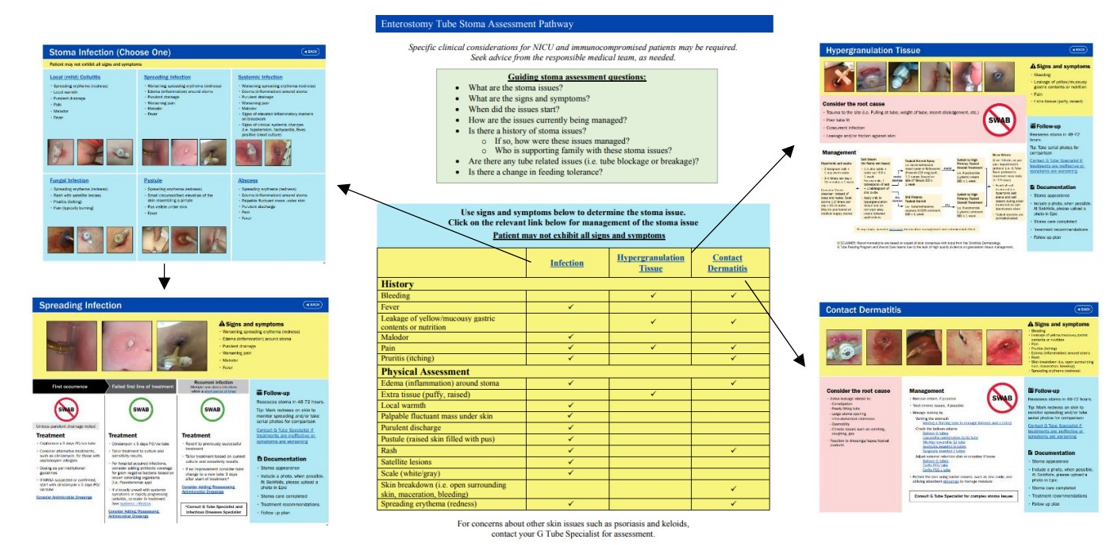ALERT: How to assess and manage enterostomy tube stoma infections in home and community?
Connected Care Quick Hits are up to date and evidence based recommendations for the care of children with medical complexity & technology dependence, from hospital to home.
ALERT: How to assess and manage enterostomy tube stoma infections in home and community?
SITUATION:
This QuickHit was informed by a new Enterostomy Tube Stoma Assessment Clinical Practice Guideline (CPG) from SickKids.
BACKGROUND:
Many children with medical complexity rely on enteral feeding tubes to support nutrition, hydration, and/or medication administration. Enterostomy tube stomas are potential sites of skin infection, hypergranulation tissue, skin breakdown, and/or sensitivity. A lack of information or experience with assessment of stoma issues may lead to unnecessary diagnostic testing (e.g., swabs), overtreatment with antibiotics, avoidable costs to family for healthcare visits, and increased health care use (e.g., clinic and emergency visits).
Stoma infections occur on a continuum, from mild to severe, with accurate assessment, diagnosis, and treatment leading to optimal outcomes for children. The Enterostomy Tube Stoma Assessment Clinical Practice Guideline promotes a standardized and evidence-based approach to the assessment and management of common stoma issues encountered by families and nurses in homecare, such as infection.
Interactive Enterostomy Tube Stoma Assessment Pathway from CPG
ASSESSMENT:
When a child is experiencing stoma issues, there are several assessment questions to be considered including:
What are the signs and symptoms?
When did the issues start?
How are the issues currently being managed?
Is there a history of stoma issues?
If so, how were these issues managed in the past?
Who was supporting family with these stoma issues?
Are there any tube related issues (e.g., tube blockage or breakage)?
Is there a change in feeding tolerance?
Healthy stomas may have a distinct pink, red or darker ring around it, that does not spread across the abdomen. It is normal for thin, clear yellow or green sticky drainage to be present around the stoma. The drainage can be cleaned daily to prevent build up.
Examples of Healthy Stomas
Signs and symptoms of a stoma infection may include the following:
Local Cellulitis
Increased and/or spreading redness around the stoma
Purulent or foul-smelling discharge from the stoma
Pain or increased tenderness to stoma
Pruritus (itching)
The skin feels warmer around the stoma than the rest of the skin
Fever
Systemic Infection
Worsening pain, swelling, and spreading redness around the stoma
Signs of clinical systemic changes (e.g., hypotension, tachycardia, fever, irritability)
Examples of Stoma Infections
RECOMMENDATION:
Connected Care, informed by the Enterostomy Tube Stoma Assessment Clinical Practice Guideline, recommends the following in the assessment and management of stoma infections:
Prevention
Stoma infections can be prevented through routine stoma care, including:
Daily cleaning of the skin and tube with mild soap and water
Washing your hands before handling the tube and stoma
Keeping the stoma dry and open to air
Screening
Utilize the Enterostomy Tube Stoma Assessment Pathway to assess the stoma and help determine the issue (e.g., infection, hypergranulation tissue, or contact dermatitis).
Testing
Wound swabs are not routinely recommended for G tube site infections because all wounds are contaminated with microorganisms. When appropriate, the technique for swabbing the site is the Levine wound swab technique.
Treatment
The algorithms outlined in the Clinical Practice Guideline include recommendations for management based on the severity of the infection (e.g., local infection, spreading infection and systemic infection).
If a local stoma infection is suspected, contact the child’s local G tube Specialist during business hours. If there is concern for systemic infection, seek urgent medical attention.
Close follow-up and frequent assessment of the stoma is recommended after initiation of treatment (48-72 hours), as well as documentation of the stoma appearance, treatment recommendations, and follow-up plan.
The following AboutKidsHealth article reviews prevention and management of stoma infections.







